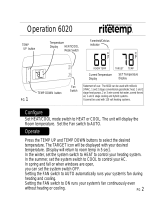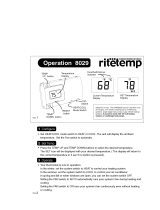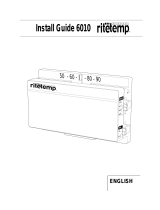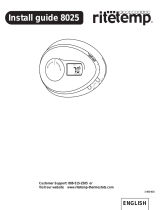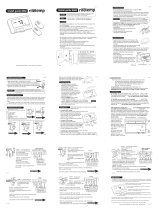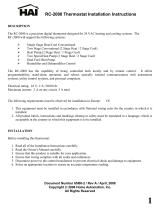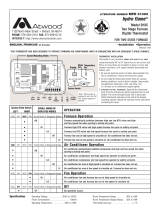Page is loading ...

1
1
PROFESSIONAL REFERENCE GUIDE updated 21dec07
INDEX
Pg. contents
1. Index
2. How thermostats work
3. Thermostat general wiring chart
4. Heat pump operation
5. 2 Wire Heat, Gas millivolt system wiring
6. 2 Wire Heat, 24VAC wiring
7. 3 Wire Heat, and Fan wiring
8. 4 Wire Heat, Fan, and Cool
9. 5 Wire Heat, Fan and Cool (two power wires)
10. 5 Wire 2 heat, fan, and cool
11. 4 Wire Heat Pump (without auxiliary heat)
12. 5 Wire Heat Pump (with auxiliary heat)
13. Zoned Forced Air Heating and Cooling 6 wire (main) 3 wire (remotes)
14. Zoned hot water systems 3 wire
15. RV, Swamp coolers, Mobile Home systems
16. Line Voltage thermostats (single pole and double pole)
17. Line voltage cooling and Controlling humidity
18. Humidifying
19. De-humidifying using the A/C or using an external de-humidifier
20. De-humidifying (using an External humidistat)
21. Thermostat Power (and remote power)
22. Fan control: Manual, heating, cooling
23. General Information: swing, anticipator, accuracy, calibrate room temp
24. General Info continued: Compressor delay, differential, reset
25. Trouble shooting: fan, heat, compressor, 24VAC, Short cycle
26 Test long cycling, fan not running, random resets, B wire info.
27. Safety

2
2
THERMOSTATS FOR HVAC (heat, ventilation, air conditioning)
A thermostat is an electronic switch much like a light switch, i.e., the switch is either ON
(contacts closed) or OFF (contacts open). In a thermostat this is done several ways.
1. The old mercury thermostats use a vial of mercury. When the vial is tipped one
way, the mercury closes two contacts at that end by touching them both. When the
vial is tipped the other way, it opens those two contacts. The vial of mercury is
connected to a bi metal spring that reacts to temperature tipping the vial back and
forth. The use of mercury is no longer acceptable, but there are many still in use.
Dispose of mercury very carefully as it is extremely dangerous. Call your local
recycler to find a disposal station.
2. Some mechanical thermostats use a bi metal device that causes the two contacts to
touch or open depending on temperature.
3. Modern electronic thermostats use what is called a magnetic latching relay. This
is a device that has two contacts that close when a coil on the relay is pulsed with
a voltage. To open it, a second coil is pulsed and the contacts open. The voltage
pulses are generated by the electronics inside the thermostat. The electronics is
what makes thermostats different from each other. The purpose of most
thermostats is to close two contacts to turn on an HVAC function and to open
them to turn off that function.
There are 3 main power sources used for switching HVAC functions on and off, Gas
Millivolt (750mv), 24VAC and line voltages of 115VAC or 230VAC.
1. The Gas millivolt system requires the thermostats to switch only about 750Mv
(3/4 volt) to turn on and off the gas heat. Any 24VAC thermostat can be used.
2. The 24VAC systems require the thermostat to switch 24VAC. All low voltage
thermostats will easily switch these two systems on and off. This is the most
popular. These cannot be use for line voltage heating or cooling.
3. The 115VAC or 230VAC is used for electric baseboard, wall heaters, or ceiling
heat; this takes a special “LINE VOLTAGE” Thermostat.
If the old thermostat has 2 or 4 large, stiff wires, coming out of a plastic or metal box in
the wall (J box), it is likely the system is 115/230VAC, and must use a line voltage
thermostat. Connecting line voltage to a 24VAC thermostat is dangerous and will
severely damage the thermostat. Always shut off power before replacing any thermostat.
Standards for identifying low voltage thermostat wiring are set by the National Electrical
Manufacturers Association (NEMA) Standards Publication DC 3-2003. These standards
set down what letters to be used for what function in thermostats. Though many
thermostats adhere to those standards, some thermostats do not. Below is a wiring chart
to help compare wiring letters in most systems. As we discuss various HVAC systems,
we will be using the NEMA standard letters for our thermostats. Refer to this chart when
replacing old thermostats that do not have the same letters as the Ritetemp thermostats.
There is no standard for wire colors.

3
3
VERY IMPORTANT NOTICE!!
BEFORE REMOVING WIRES FROM THE OLD THERMOSTAT, LOOK AT
THE LETTERS NEXT TO EACH WIRE AND MARK THE WIRES WITH THE
SUPPLIED LETTERS. USE THE CHART BELOW TO CROSS REFERENCE.
ANY WIRES THAT WERE NOT CONNECTED TO THE OLD THERMOSTAT
OR NOT USED ON THE NEW THERMOSTAT SHOULD BE TAPED OFF AND
PUSHED BACK INTO THE WALL.
THERE IS NO COLOR CODE FOR THERMOSTAT WIRES
THOUGH THE COLOR OF THE WIRE MAY MATCH THE LETTER OF THE
WIRE, THE COLORS THEMSELVES SHOULD NOT BE CONSIDERED.
OLD THERMOSTAT NEW THERMOSTAT (NEMA standard) DESCRIPTION
WIREING FOR NORMAL HEATING AND COOLING (gas/oil/elect) (no heat pump)
R, or RH, or 4, or V RC/RH (connected) Single power wire
W or H W Heat return
W2 or H2 W2 2
nd
stage of heat
W3 W3 3
rd
stage of heat
Y or M Y Cool return (compressor)
Y2 Y2 2
nd
stage of cool
Y3 Y3 3
rd
stage of cool
G or F G Fan return
C or X C 24VAC thermostat power
FOR SEPARATE HEAT AND COOL POWER, REMOVE THE RH/RC JUIMPER
AND WIRE AS SHOWN BELOW:
RH and R RH to RH and R to RC RH = Pwr heat and R= Pwr cool
4 and R 4 to RH and R to RC 4 = Pwr heat and R = pwr cool
RH and RC RH to RH and RC to RC RH = Pwr heat and RC = Pwr cool
WIRING FOR HEAT PUMP
R RH/RC (connected) Power
Y Y and W Compressor (used for heat and cool)
W2 W2 Heat pump Aux heat
E W2 Emergency heat
O O Changeover (Powered in COOL)
or or Do not connect both O and B!
B B Changeover (Powered in HEAT)
Florida Heat Pump (4 wire aqua) may use W as changeover (connects to terminal O)
On a heat pump, if O and B are both present, connect O wire to O terminal and B
wire to C terminal (TRANE HEAT PUMP PRODUCTS). Do not connect B wire to
B terminal as it may damage the 24VAC power system.

4
4
ZONED HOT WATER MOTOR VALVES
5 or R RH Power wire
4 or W or NO W Turn Valve on
6 or Y or NC A Turn Valve off
ZONED HOT WATER SOLENOID VALVES
R RH power
Y or B or N/O W Turn Valve off
W or N/C A Turn Valve on
Heat Pump Operation
To better understand heat pumps, go to a drawing at: www.dhclimatecontrol.com/hp.htm
Heat pumps are a unique method of heating. Essentially it is a reversible air conditioner.
An A/C pumps heat out of the house into an outside air exchanger and into the outside
air. A heat pump uses very similar equipment and pumps heat from the outside air into
the inside air exchanger and into the house. The heat pump has a “reversing valve” to go
from COOL to HEAT. An AIR CONDITIONER gets less efficient in cooling a house as
the outside air gets hotter. Similarly, the HEAT PUMP gets less efficient as the outside
air gets colder.
AUXILIARY HEAT (for heat pumps)
In moderate to cold climates, the heat pump cannot keep the house warm if the outside
air gets too cold. Most air exchange heat pumps have an additional heat source called
AUXILIARY heat and is often electric heat strips but can be GAS or OIL. This auxiliary
heat comes on to help bring the house temperature up quicker and/or provide heat when
the heat pump can no longer keep up (outside temp. below 30F). Most heat pump
thermostats have an EMER (emergency) or AUX ONLY switch or button to allow the
auxiliary heat to be the only source of heat if the heat pump quits or can not keep up.
Some heat pumps do not need auxiliary heat if they are used in warm climates and/or if
instead of using air heat exchangers, they can use ground or water (wells) heat
exchanging. Ground and well temperatures stay very constant (typically 60F) so make
excellent heat exchanger medium for pulling out heat (for heating a house), or dumping
in heat (for cooling a house).
Some heat pumps may be 3 stages; 1 stage of compression and 2 stages of aux heat, or 2
stages of compression and 1 stage of aux heat.

5
5
The following drawings will help explain how the thermostats relay control and
operate the HVAC systems.
GAS MILLIVOLT HEAT ONLY 2 WIRE
Below is a typical Gas Millivolt system. When the thermostats relay (switch) connects
RH to W, the heat comes on. If the heating system already has a thermostat connected,
use the same two wires that were on the old thermostat. When there are just two wires,
there is no polarity, i.e., either wire can go to RH or W.
WRH
PILOT LIGHT GAS FLAME
MILLIVOLT GENERATOR
OVERHEAT SWITCH
GAS CONTROLLER
BURNER
TYPICAL GAS MILLIVOLT HEATING SYSTEM
GAS FURNACE, GAS FIREPLACE, SWIMMING POOL HEATER, ETC.
FOR MILLIVOLT GAS HEATERS WITH PILOT LIGHTS
TH TH/TP
TP
PILOT
OFF
ON
TYPICAL CONTRO
L
WHEN RH CONNECTS TO W, THE HEAT COMES ON
GAS INPUT

6
6
LOW VOLTAGE 24VAC HEAT ONLY 2 WIRE
The drawing below is a typical heating system using 24VAC. The heating system has a
transformer that generates 24VAC to operate the furnace low voltage thermostat
controlled system. The 24VAC is not an electrical hazard. It can use much smaller wire
than line voltage systems, and does not need an electrical box in the wall.
When terminals RH and W are connected together by the thermostats relay
(switch), the 24VAC (RH) connects to the furnace relay (W) and the heat comes on.
When the relay opens the contacts, the heat goes off. This relay is operated by the
thermostats computer which follows your programming commands. Some heating
systems immediately come on. Some take a few seconds. With just two wires, the
heating systems fan is controlled by the furnace, not by the thermostat. With only two
wires, there is no polarity, ie, either wire can go to RH or W.
If a C wire is available at the thermostat, it can be used to run the thermostat in
place of batteries or in addition to batteries for memory back up with longer battery life.
The “C” wire is always available in a 24VAC system as it is the side of the 24VAC heat
transformer that goes to all the HVAC relays. Most HVAC techs can find this point and
run a wire to the thermostat if there is not one. Do not touch RH and C together.
WRH
HEAT RELAY
PS
24VAC TRANSFORMER
24VAC115VAC HEAT CONTROL
RH W
C
FOR ANY TWO WIRE, 24VAC HEATING SYSTEM
RELAY CLOSES FOR HEAT TO BE ON
GAS
,
OIL
,
ELECTRIC
,
HOT WATE
R
TYPICAL 24VAC, 2 WIRE HEATING ONLY SYSTEMS
IN THE THERMOSTAT, WHEN RH CONNECTS TO W, THE HEAT RELAY CLOSES.

7
7
24VAC HEAT AND FAN 3 WIRE
The drawing below is a 24VAC, three wire heat control system controlling both HEAT
and FAN. The 24VAC provides power to the HEAT CONTROL relay and the FAN
CONTROL relay through the thermostat.
Most gas or oil heating systems control the fan so the air is not circulated until the air is
heated in the furnace and then left on after the heat is shut off to purge the heat out of the
system; they do not need the thermostat to control the fan.
The G wire allows the thermostat to control the fan when the fan switch is in the ON
position and/or when the GAS/ELEC jumper is in ELEC. Most electric furnaces do not
have a fan control and must have the thermostat turn on the fan whenever the electric
furnace is turned on. This is necessary to circulate the warmed air into the house and
keeps the electric elements from overheating. Some thermostats also leave the fan
running for 1 minute after the heat is shut off to purge the heat out of the system.
GWRHRC
HEAT RELAY
PS
24VAC TRANSFORMER
24VAC115VAC
RH or R W
C
FOR THREE WIRE, FORCED AIR 24VAC HEATING SYSTEM
RELAY CLOSES FOR HEAT
GAS, OIL, ELECTRI
C
TYPICAL 24VAC, 3 WIRE HEATING ONLY SYSTEMS
CONNECTING RH TO W = HEAT
FAN RELAY
FAN CONTROL
CONNECTING RC TO G = FAN
G
RELAY CLOSES FOR FAN
RC/RH connected

8
8
24VAC HEAT, FAN, AND COOL 4 WIRE
The drawing below is a standard 24VAC, 4 wire heating and cooling control system.
(Not a heat pump). With the thermostats mode switch in the HEAT position, the heating
functions are the same as in the 3 wire heating system.
When the thermostats mode switch is in the COOL position, the thermostat turns on the
air conditioner’s compressor and the air handler circulating fan at the same time.
Note the RC (power cool) and RH (power heat) terminals are connected together. This is
because in a 4 wire heating and cooling system, there is a single 24VAC power
transformer for both the heat and cool.
GYWRC/ RH
HEAT RELAY
PS
24VAC TRANSFORMER
24VAC115VAC
RW
TYPICAL 24VAC, 4 WIRE HEATING & COOLING SYSTEM
HEAT = R to W
FAN RELAY
FAN = R to G
G
COOL RELAY
Y
COOL = R to Y
THERMOSTAT CONTROLLER
TYPICAL THERMOSTAT
BATTERIES
COMPRESSORHEATER FAN
WIRES FROM HVAC TO THERMOSTAT
THERMOSTATS ISOLATION RELAY
S
THERMOSTAT POWER
THERMOSTAT MICROCONTROLLER
TYPICAL HVAC SYSTEM
C

9
9
24VAC HEAT, FAN and COOL 5 wires (with separate heat & cool power)
The drawing below is a standard 24VAC, 5 wire heat and cool controls system. Some
times, the heating and cooling systems have their own separate 24VAC power so there
are two power sources, RC (cool and fan) and RH (heat).
The 24VAC HEAT transformer provides power to just the HEAT relay. The 24VAC
COOL transformer provides power to the FAN relay and the COOL (compressor) relay.
When there are two power sources, the strap between RC and RH must be removed or
damage may occur! The RC wire and the RH wire must never touch each other.
It is important for the customer to turn off his power before he disconnects the old
thermostat!
The 5 wire heating and cooling functions are the same as the 3 and 4 wire drawings. Note
when there are two transformers, the C wire comes from the HEAT transformer.
GYWRHRC
HEAT RELAY
PS
HEAT 24VAC
24VAC
RH WC
FOR FIVE WIRE, FORCED AIR, 24VAC HEATING AND COOLING SYSTEM
GAS, OIL, ELECTRI
C
TYPICAL 24VAC, 5 WIRE HEATING & COOLING SYSTEM
FAN RELAY
FAN = RC to G
G
COOL RELAY
Y
COOL = RC to Y
PS
COOL 24VAC
RC
24VAC
HEAT = RH to W
THERMOSTAT
HVAC

10
10
24VAC TWO STAGE HEAT AND SINGLE STAGE OF COOL 5 WIRES
The drawing below is the wiring of a typical two stage heating system and not a heat
pump. From a setback of over 2F, when heat is requested by our thermostat, the first
stage comes on and after 1 minute the thermostat turns on the 2
nd
stage of heat which also
increases the fan speed. Both stages stay on all the way to target and then both stages
shut off. This allows much faster recovery from a set back. After that the 1
st
stage
generally can maintain the room temperature which is more efficient and quieter.
However if the room temperature drops below the “differential” (typically -2F) below
the room temperature because the first stage cannot keep up, then the 2
nd
stage again
comes on with the 1
st
stage and both run all the way to target. Also, if the customer wants
to increase the room temperature faster, when he turns the target up over 2F above the
room temperature, he gets more heat faster as the 2
nd
stage comes on all the way to the
new target.
Some other thermostats do not turn on the 2
nd
stage for 15 minutes after the 1
st
stage
comes on which slows down recovery.
GYWRHRC
PS
24VAC
RC
FIVE WIRE, FORCED AIR, 24VAC, 2 STAGE OF HEATING AND SINGLE STAGE OF COOLING
1ST STAGE HEAT RH TO W
FAN = RC TO G
GY
COOL = RC TO Y
1ST STAGE HEAT
W2
2nd STAGE HEAT RH TO W2
RELAY RELAY
COMPRESSOR FAN2ND STAGE HEAT
W2
RELAY RELAY
W
SYSTEM COULD HAVE 6 WIRES IF THE HVAC SYSTEM HAS SEPERATE RH AND RC

11
11
24VAC HEAT PUMP WITHOUT AUXILIARY HEAT 4 WIRE
The drawing below is a heat pump without auxiliary heat. This is useful with an air heat
exchanger (outside unit) in mild climates like Florida and parts of Arizona. If the heat
exchanger is in the ground or in a well (hydro), it is very efficient and auxiliary heat is
not necessary.
Notice the thermostats W (heat) and Y (cool) are connected together. This is because the
compressor is used when the thermostat calls for heating (W) or cooling (Y). The
terminals O or B control the changeover relay which determines if it will be heating or
cooling.
Heat pumps do not control the fan; thermostats used for heat pumps must have the
GAS/ELECT jumper in the ELECT position.
In a heat pump, never connect both O and B or damage may result. See wiring pg 3.
NOTE: Some heat pumps use other letters for the changeover. Florida Heat Pump Co.
uses the letter W on the old thermostat instead of O. (Connect their W to the stats O)
For more information about heat pumps go to: www.dhclimatecontrol.com/hp.htm
GYWRHBORC
PS
24VAC
RC
FOUR WIRE, FORCED AIR, 24VAC, HEATING/COOLING HEAT PUMP WITHOUT AUXILIARY HEAT
TYPICAL 24VAC, HEAT PUMP WITHOUT AUXILIARY HEAT
HEAT = RH TO W
FAN = RC TO G
GY
COOL= RC TO Y
O or B
NOT BOTH
OB
REVERSING
O or B
CHANGEOVER
VALVE RELAY RELAY RELAY
COMPRESSOR FAN
CHANGE OVER RH/RC to O or B (not both)

12
12
24VAC HEAT PUMP WITH AUXILIARY HEAT 5 WIRE
The drawing below is a heat pump with auxiliary heat. The auxiliary heat is usually
electric heat strips mounted on the air output of the heat pump. This type of system is
typically used where there is no natural gas available in cool to cold climates.
From a set back of over -2F our thermostats turn on the heat pump and after 1 minute turn
on the aux electric heat. Both stay on all the way to target for fast recovery and then both
shut off. The heat pump will then attempt to maintain the target room temperature. If the
heat pump cannot keep up because the outside temperature is too cold, when the room
temperature drops below -2F, the electric aux heat comes on with the heat pump all the
way again to target. If the heat pump quits, the aux electric heat will still keep the room
temperature within 2F of room temperature.
However, the auxiliary heat can also used by itself if the heat pump quits or just can’t
keep up. When the thermostat is switched to AUX HEAT ONLY the heat pump is shut
off and only the AUX heat is used and will maintain the target temperature.
Heat pumps do not control the fan; thermostats used for heat pumps must have the
GAS/ELECT jumper in the ELECT position.
GYWRHBORC
PS
24VAC
RC
TYPICAL 24VAC, HEAT PUMP WITH AUXILIARY HEAT
HEAT = RC/RH TO Y/W (Changeover in HEAT
)
FAN = RC TO G
GY
COOL= RC/RH TO Y/W (Changeover in COOL)
O or B
NOT BOTH
OB
REVERSING
O or B
CHANGEOVER
W2
AUX HEAT = RC/RH TO W2
VALVE RELAY RELAY RELAY
COMPRESSOR FANAUXILIARY
HEAT
W2
CHANGEOVER = RC/RH to O or B (not both)
If the heat pump AUX HEAT is gas or oil it is installed at the air input side of the heat
pump and cannot run when the heat pump is running or it would overheat the heat
exchanger. So if the thermostat is set for GAS/OIL AUX HEAT, the thermostat will shut
off the heat pump when the aux heat comes on. The heat pump is used for maintaining
room temperature and the gas or oil aux heat is used for recovery.

13
13
24VAC ZONED FORCED AIR HEATING AND COOLING 6 WIRE (main)
The drawing below is a forced air, zoned, heating and cooling system with remote
thermostats for different areas. The master control unit opens and closes baffles in the
forced air system to open an area or close an area for either heating or cooling. This
allows different areas of the house to be at different temperatures as a function of the
areas own thermostat using a single HVAC system.
The selection of HEATING or COOLING is made by the master controller. If the
customer wishes to use programmable thermostats at the remotes, they must remember to
switch the remotes from HEAT to COOL whenever they switch the main thermostat from
HEAT to COOL. This is because the heating and cooling programs are different.
Some forced air zoned systems master controllers use both B and O for changing from
HEAT to COOL and some use just one of the letters, B or O. Be sure it is a gas forced air
zoned system before connecting both O and B.
Some of the names of forced air zoned heating are Durazone, Trol-a-temp.
AGYWRHBORCC
RW GY
ZONE FORCED AIR HEATING AND COOLING (such as Trol-a-temp)
MASTER CONTROL UNIT
MAIN THERMOSTAT
REMOTE THERMOSTAT
RC RH W Y
STRAP
RC RH W Y
REMOTE THERMOSTAT
OB
FOR SELECTION OF HEAT OR COOL
AND ZONE BAFFEL CONTROLS
STRAP
STRAP
NOTE: Be sure your system is not a heat pump before connecting O and B.
Connecting both O and B in a heat pump, can cause damage to the HVAC system.

14
14
ZONE HOT WATER HEATING SYSTEMS (3 wires to thermostat)
The drawing below is a zoned hot water system that uses a 3 wire thermostat control
system to open and close a rotary valve or a solenoid valve.
NOTE: If a hot water system has just two wires, connect it as a standard 2 wire
heating system between RH and W.
ROTARY VALVE
When the thermostat requests heat, RH connects to W and the rotary motor controlled
valve opens. When the thermostat requests the heat go off, the RH to W connection opens
and the RH to A connects and the rotary motor controlled valve closes. Each valve has a
switch to turn the boiler on and off so the boiler can be turned on by any zones rotary
switch.
SOLENOID VALVES (note reverse wiring from rotary connections)
When heat is not requested, RH is connected to A and holds the solenoid valve in the
OFF position (powered off). When heat is requested, RH disconnects from A which lets
the solenoid go and its spring opens the valve. At the same time, RH connects to W and
turns on the boiler. Any zone’s thermostat can turn on the boiler. If the valve or its power
fails, the valve springs open and allows some heating by convection.
Rotary Solenoid
AWRH
C
R or 5 W or 4
Y or B or 6
REMOTE THERMOSTAT
PS
MOTOR CONTROLLED VALVE WITH SWITCH
24VAC
VALVE OPEN VALVE SHUT
CONNECTION FOR MOTOR CONTROLLED VALVES
AWRH
C
R W
Y or B
REMOTE THERMOSTAT
PS
24VAC
VALVE OPEN VALVE SHUT
CONNECTION FOR SINGLE SOLENOID VALV
E
SPRING
BOILER CONTROL
SOLENOID
N/O N/O
N/CN/C
HEAT RELAY HEAT RELAY
NOTE VALVE IS POWER OFF SO TERMINAL "A "

15
15
RV’s, 2 speed fan’s, and Swamp Coolers
PROPANE FURNACE
PROPANE FURNACE
AIR CONDX
AIR CONDX
RC RC RHRH YYWWG
G
R or GROUND
W or FURN
Y or A/C
THERMOSTAT
24VAC CONTROL RV A/C
12VDC CONTROL RV A/C
12VDC CONTROL RV PROPANE HEATER 12VDC CONTROL RV PROPANE HEATER
BATTERY - (gnd) BATTERY - (gnd)
7.5V
CAP OFF
W or FURN
R or PWR or GND
G2, F2, H
G, G1, F1
Y or A/C
RC
THERMOSTAT
G2, F2, H
G, G1, F1
ALTERNATE
FAN
CONNECT
CONNECT G2 TO G FOR HIGH FAN
JUMPER AND USE AUTO/ON FOR FAN SPEED
REMOVE THE THERMOSTATS GAS/ELEC
All RV air conditioners run on 115VAC and the RV must be connected to AC power for
the air conditioner to operate. No Air Conditioning test can be done with out AC power.
SWAMP COOLERS
Swamp coolers connect like any A/C system (RC, Y, and G). If there is a two speed fan,
connect just the G fan wire to the thermostats G terminal for low, or both fan wires (G
and G2) for high. The alternate fan connection above right allows the use of the
thermostats fan AUTO/ON switch to be a LOW (auto) and HIGH ( on) manual switch.
Do not use a 24VAC thermostat for a line voltage swamp cooler.
MOBILE HOME
Some mobile homes have a 2 wire thermostat for heating and cooling. The
HEAT/OFF/COOL switch is on the side of the HVAC system. Typically in this case,
connect the two wires going to the thermostat to RH and W.
Leave the thermostat always in HEAT; do not switch the thermostat to cool.
GYWRHBORCC
HEAT RELAY
PS
24VAC115VAC
COOL RELAY
MOBILE HOME WITH MODE SWITCH ON SIDE OF HVAC UNI
T
MODE SWITCH ON UNIT
THERMOSTAT
HC
OFF

16
16
LINE VOLTAGE THERMOSTATS
NOTE: Line voltages are very dangerous and the power to the heating system
should be shut off before changing the thermostat! These are typically used for
baseboard, wall, ceiling and floor heating systems.
LINE VOLTAGE DOUBLE POLE (4 large wires)
The DOUBLE POLE type will have 4 large wires coming out of the thermostat. To
connect to 4 large wires coming out of an electrical box in the wall. Do not connect a
24VAC thermostat to line voltage or severe damage will occur to the thermostat.
TO HEATER
LINE VOLTAGE THERMOSTAT
POWER ON/OFF SWITCH IN THERMOSTAT
HEATING ELEMENT
T1
T2
L1
L2
LINE IN
LOAD
RED
RED
BLACK
BLACK
FROM BREAKER BOX
BLACK
WHITE
WIR E
NUTS
THERMOSTAT
DOUBLE POLE: BOTH SIDES OF POWER GO THROUGH THE THERMOSTAT
MAX RATING AT 230VAC AT 16 AMPS (about 3680 Watts)
MAX RATING AT 115VAC AT 16 AMPS (about 1840 Watts)
LINE VOLTAGE SINGLE POLE HEATING (2 large wires)
The SINGLE POLE type will only have two large wires coming out of the thermostat.
THERMOSTAT IN HEAT
HEATING ELEMENT
BLACK TO LINE
RED TO LOAD
FROM BREAKER BOX
BLACK
WHITE
WIR E
NUT S
THERMOSTAT
BLACK
WHITE
SINGLE POLE: JUST ONE SIDE OF THE POWER GOES THROUGH THE THERMOSTAT
THE OTHER SIDE OF THE POWER GOES DIRECTLY TO THE HEATING ELEMENT
MAX RATING AT 230VAC AT 16 AMPS (about 3680 Watts)
LINE IN
MAX RATING AT 115VAC AT 16 AMPS (about 1840 Watts)

17
17
LINE VOLTAGE SINGLE POLE COOLING (2 large wires)
Some line voltage thermostats can be used for heating OR cooling as below. They will
have a switch to select HEAT OR COOL (not both).
THERMOSTAT IN COOL
COOLING DEVICE
BLACK TO LINE
RED TO LOAD
FROM BREAKER BOX
BLACK
WHITE
WI R E
NUTS
THERMOSTAT
BLACK
WHITE
CONNECTION FOR LINE VOLTAGE COOLING THERMOSTAT (SWAMP COOLER ETC)
MAX RATING AT 230VAC AT 16 AMPS (about 3680 Watts)
LINE IN
MAX RATING AT 115VAC AT 16 AMPS (about 1840 Watts)
CONTROLLING HUMIDITY (Thermostat equipped with a built humidistat)
HUMIDIFIER
If you have a humidifier and wish your thermostat with a built in humidistat to control it,
connect the humidifier as shown below. The MIN (minimum) humidity setting on the
thermostat will now turn the humidifier on and off as a function of the humidity level in
your home.
If the humidistat is set for ALWAYS, when humidity is requested by the humidistat, the
humidifier and the fan will be turned on until the humidity is at the target (about +/- 5%).
If the humidistat is set for WITH HEAT ONLY, the humidifier will not come on until
there is both a request for heat and a request for humidity at the same time. When either
heat or the humidistat is satisfied and shuts off, the humidifier will shut off.
NOTE: If your thermostat has a built in humidistat (with an H terminal), and your heating
system has a built in humidifier, connect it as below using the HVAC 24VAC power.
PS
115VAC
RH
HUMIDFIER CONNECTION USING THE HEATING SYSTEM 24VA
C
H
HUMIDIFIER RELAY
HEAT 24VAC
R
C
FURNACE TRANSFORMER

18
18
NOTE: If your heating system has an added humidifier with its own separate 24VAC
connect it as below.
PS
115VAC
RH
HUMIDIFIER WITH EXTERNAL 24VAC ADAPTER
H
HUMIDIFIER RELAY
HEAT 24VAC
R
C
FURNACE TRANSFORMER
24VAC
EXTERNAL 24VAC WALL ADAPTER
OPTIONAL " FAN RUNNING" SWITC
H
CONNECTING AN EXTERNAL HUMIDISTAT FOR HUMIDIFING
If you have an existing humidifier, with an external humidistat, and wish it to be active
only when the thermostat is switched to HEAT, connect the power wire (R) from your
humidistat to the B terminal of your thermostat (if it has one).
When the mode switch is put in HEAT, the B terminal is powered from the RH terminal,
which will power the external humidistat. The humidistat will then operate independent
of the thermostat settings. When the thermostat is switched to OFF or COOL, the external
humidistat will be off.
WRHB
PS
24VAC
RH WC
HUMIDIFIER CONNECTION WITH AN EXISTING EXTERNAL HUMIDISTA
T
HUMIDIFIER RELAY HEAT RELAYHEAT 24VAC
H
EXTERNAL
HUMIDSTAT
THERMOSTAT
HVAC
POWERED IN HEAT ONLY

19
19
DE-HUMIDIFYING (humidistat using the air conditioner)
Some thermostats internal de-humidifier can use an air conditioner for de-humidifying or
can use an external dehumidifier (DH terminal). The A/C can be used for de-humidifying
or cooling, or can be set up to dehumidify only when also cooling is also required.
DE-HUMIDIFYING USING AN EXTERNAL DE-HUMIDIFIER
If a system has an external de-humidifier unit, it de-humidifies but is temperature neutral
so does not add cooling to the house. If your thermostat as a humidistat that can use an
external de-humidifier (DH terminal) then it can be connected as below using the cool
24VAC power source.
YRC
PS
COOL
115VAC
RC
CONNECTION WITH AN EXTERNAL DE-HUMIDIFIER
COOL RELAY
THERMOSTAT
EXTERNAL
DE-HUMIDIFI ER
DH
Y
USING HVAC 24VAC POWER
HVAC
POWER
If a system has an external de-humidifier unit, it de-humidifies but is temperature neutral
so does not add cooling to the house. If your thermostat as a humidistat that can use an
external de-humidifier (DH terminal) then it can be connected as below using a separate
24VAC power source.
YRC
PS
24VAC115VAC
RC
CONNECTION WITH AN EXTERNAL DE-HUMIDIFIER
COOL RELAY
THERMOSTAT
EXTERNAL
DE-HUMIDIFIER
DH
Y
USING SEPERATE 24VAC POWER
24VAC ADAPTE
R
HVAC

20
20
CONNECTING AN EXISTING HUMIDISTAT FOR DE-HUMIDIFING
NOTE: The power to the external humidifier should come from the thermostats O
terminal which is powered only in the cool mode so the HEAT and the A/C cannot be on
at the same time.
PARALLEL: The air conditioning can be turned on by either the humidistat with high
humidity over its target or by the thermostat because of high temperature over its target.
YORC
PS
24VAC115VAC
RC
DE-HUMIDIFIER CONNECTION WITH AN EXISTING EXTERNAL HUMIDISTA
T
COOL RELAY
HUMIDISTAT
EXTERNAL
PARALLEL: EITHER HIGH TEMPERATURE OR HUMIDITY WILL TURN ON THE AIR CONDITIONER
SERIES: The air conditioning will come on only with high humidity over its target and
high temperature over its target.
YRC
PS
24VAC115VAC
RC
DE-HUMIDIFIER CONNECTION WITH AN EXISTING EXTERNAL HUMIDISTA
T
COOL RELAY
HUMIDISTAT
EXTERNAL
BOTH TEMP AND HUMIDITY MUST BE ABOVE TARGET TO TURN ON A/C
Y
THERMOSTAT
/
